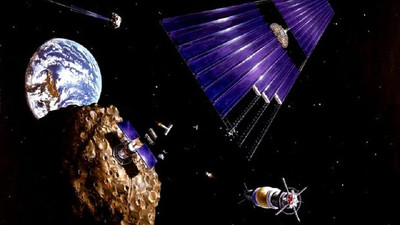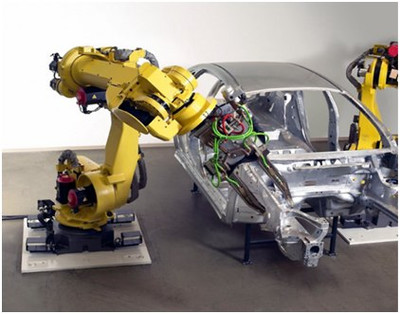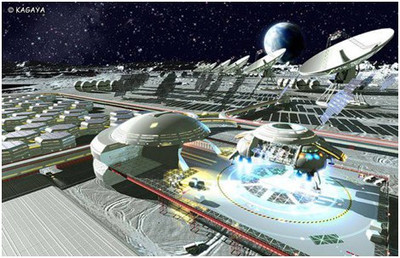
The concept of the movement towards the transition of the earthly civilization to the cosmic level, through the development of the space industry of the space age, based on technologies and methods of organization that are relevant in the future space space industry and on earth during the cosmic period of development, and allowing the fuller colonization of space to be launched more quickly.
Space expansion is one of the main, promising, directions of human development. With the beginning of a full-scale industrial colonization of the cosmos, mankind will pass to the level of cosmic civilization. And having access to unlimited resources of the solar system, it will be able to raise its level of development to a previously unattainable height. Now it is considered that the creation of the world space industry is extremely difficult, expensive and long-term task. According to the plans of space administrations and private space corporations, the space industry will develop gradually, through a number of scientific and commercial space programs. Such as the Lunar and Martian bases, the extraction of lunar and asteroid resources. But the main goal of space expansion, and the main frontier separating the terrestrial civilization from the cosmic one is the creation of the world space industry. Alien bases, experimental extraction of extraterrestrial resources, only intermediate stages.
I propose a new approach to the development of the world space industry, to begin its creation not in space programs, but on the ground, in the form of a mass industry based on principles and technologies that will be relevant in the space industry of the future and on earth during the space period of civilization development. "The space age industry", can begin its development in the near future, and quickly prepare the world industry for a transition beyond the boundaries of the earth. This approach allows us to move towards the main goal of space expansion, the creation of the world space industry, straightforwardly, without long-term intermediate stages, and without formidable barriers.
Technological basis of the space age industry, should be small production micro-factories, "Replicators", capable of producing a wide range of industrial products, including making sets of parts from which they are assembled. Make copies of yourself. Such micro factories will allow many times to accelerate the growth of industry and economy on earth. And in some perspective, their space versions will allow to begin the industrialization of space, without huge expenses, but with high speed and high economic efficiency. The organizational basis for the space age industry should be networked structures based on self-management and partnership of participants. Working mainly in the field of small and medium-sized businesses, which have high rates of distribution, growth and quality development. At the initial stage, the space age industry should develop in the form of entrepreneurial communities. Working in sales and production of goods that make up the category of things that form the life environment of the space age, with the gradual modernization of its technologies, which will save significant start-up costs and other constraints.
The network structure of supporters of space expansion, in addition to the industrial direction, should include social movements and political movement, the development of networked self-organization - "Netocracy".
The concept of creating the world space industry through the earth's predecessor and prototype, the space age industry, makes it possible to translate the further development of mankind into the channel of cosmic expansion. And confidently, without significant obstacles, moving in this channel, move to the level of space civilization, in the future about 10 years. It makes the transition to the cosmic level, which is achievable in the near historical perspective.
In this concept, the leading role belongs not to states or large corporations, but to civil society. It allows everyone to become a participant in the global trend of global space expansion, and to receive for themselves new opportunities and benefits that are given by the movement along the path of development of space civilization.
Modern humanity on the threshold of the space age.

Modern humanity stands on the verge of a transition to a cosmic era, but can not step over this threshold for a long time. Constraints to space expansion are strong barriers, such as the high price and technological complexity of the industrialization of space, the lack of well-designed action plans and the lack of readiness for decisive action. Despite the half-century history of space exploration, the activities of people in the solar system remained at the research stage.
State space administrations follow the race for scientific propaganda achievements, their planning horizon, this is the creation of scientific bases on the Moon and Mars. But the beginning of the industrial development of outer space, is not even considered by them as a goal.
In recent decades, private players began to actively participate in space exploration, with more rational goals and approaches.
In the plans of space private traders, the creation of qualitatively new space transportation systems, such as: Reusable missiles, orbital tugs with economical plasma engines. "Bezrucket", methods of bringing cargoes into orbit, using cable lifts, a giant "Orbital sling", or super-powerful guns.

Projects on practical development of extraterrestrial raw materials, such as: Extraction of precious metals and rare earth elements on asteroids. The production of rocket fuel from water extracted on the moon or asteroids. In the longer term, the construction of large orbital stations, which play the role of transport, service and production centers, is being considered. And orbital solar power stations, using lunar and asteroid materials. Which, after the appearance of new transport systems, will be much cheaper than materials delivered from the ground.
The main initiative in the practical development of outer space, of course, belongs to private traders. But the plans of private traders, as there are disadvantages. They do not have a coherent global strategy for moving towards the transition of mankind to the cosmic level. And there are many insurmountable barriers. In the form of gigantic complexity and cost, large-scale programs for the industrialization of outer space. As well as in the strategy of state administrations. With the difference that the difference is that when the rocket space industry was born, the states expected to develop the industrialization of space through budgetary financing, until it became an independent industry direction. And private traders plan to develop the gradual involvement of the terrestrial industry in commercial space programs, until the industrialization of space becomes mass. The opportunities for the development of space industrialization through private firms are becoming more realistic, but also remain poorly developed, overly complex and long-term.
Plans privetnikov haphazard, not connected among themselves, in the scenario of the development of a unified transport and industrial space infrastructure of the future. As the final goals, the development of separately taken directions of practical activity in space is declared. "Space X" makes reusable missiles, "Deep Space Industries", plans to extract valuable minerals on asteroids, "Shackleton Energy Company," plans to develop rocket fuel production on the moon, and the like. But the creation and development of the world space industry, as the main goal of space activities is not considered, and accordingly there are no plans for its coordinated and speedy development. While the creation of a global space industry that allows us to embark on the full-scale development of the people of the solar system, this is the main frontier separating the terrestrial civilization from the cosmic one. The main goal of space expansion at the present stage.
The development of the space industry through private space projects will take a long time. Because it must go through several stages of growth and qualitative improvement. First, new missiles and near-Earth satellites, then lunar bases, industrial orbital stations and orbital solar power stations. Then the mass development of extraterrestrial industry may begin. By the beginning of mass industrialization of the solar system through space programs, at best, it will be possible to approach in 30-40 years. Such terms are not foggy futuristic perspectives, as in the case of colonization plans for space by state administrations. But still they remain too long to cause increased interest and massive enthusiasm for space expansion.
I am an extra-system innovator, a supporter of the colonization of space, as well as, in general, the development of universal human progress. Colonization of space, this is one of the main directions for the development of progress in the immediate historical perspective. Since it is access to unlimited resources, rapid and unlimited growth of the economy, accelerated progress in the development of technology and society. Together with the transition of mankind to the level of cosmic civilization, it will rise to a completely new, qualitative level of development. By its quality and scale, the upcoming transition to the cosmic level can be compared with the past transition to the level of modern, technological civilization with the medieval one. Which lasted about 500 years and began with the maritime, colonial, expansion of Europe. With the difference that space expansion will develop many times faster, thanks to the modern speed of progress.
The faster and more actively cosmic expansion begins, the better for progress, better for humanity.
The concept of the Earth "Industry of the Space Era", which serves as the foundation and prototype of the future, world space industry.
Thinking over how to bypass the barriers that impede the development of the space industry and accelerate the process of space expansion, I developed a qualitatively new concept that allows us to begin an active and full-scale movement towards the transition of mankind to the cosmic level in the near future. And to continue this movement without encountering significant barriers and constraints, before the full-scale industrial colonization by people of the solar system. And further, developing along the path of cosmic civilization.

The main difference of this concept is that it assumes the beginning of the development of the world space industry not in space but on earth. Through the creation of a qualitatively new industry based on principles and technologies that in the future will allow it to actively spread in the solar system. And they will also be relevant on earth during the period of space civilization. It will be an earthly, functional predecessor and prototype of the future space industry - the Space Era Industry.
The space age industry, according to the principles of its structure and its technologies, will be equally effective both on earth and in space. At the earthly stage of development, its task is to prepare the world industry for a transition beyond the boundaries of the earth. In the incubation of technology and the accumulation of industrial capacities and financial resources necessary for the beginning of mass industrialization of the solar system. The space age industry will begin to develop immediately on a global scale. And it will start to move to outer space, too, on a global scale.
This is its main advantage over private space projects, which will also serve as forerunners of the future space industry, but their financing in the scale of the world economy will be miserable. And to expand to a global scale, they will have to go through several stages of growth, which will take several decades. For the space industry of the space age, only one stage of growth is necessary before the transition to space. The space age industry can quickly involve a significant share of the world's financial and industrial potential in its development. It can reach the stage of the world space industry for a period of about ten, maximum, fifteen years. That is, it can lead to the beginning of a full-scale colonization of space in two, four times faster than it is considered to be according to the most optimistic forecasts now accepted.
The term of ten years is a close prospect by historical standards. During this time people have time to get an education or to make a career. Over the same time, capital is doubling in large investments in industry and infrastructure. If the beginning of the colonization of space becomes available in ten years, people will be prepared for it, investors will invest in it, it will cause the rise and enthusiasm in society.
Unlike modern space programs, the space age industry does not have a financing problem. It will itself serve as a source of money, and as it develops, it will accumulate resources that will later be used to industrialize the cosmos. The revolutions of the space age industry will be comparable to the world economic potential and will be measured by trillions of dollars. At the same time, the industry of the space age will begin to bring practical returns on the scale of the world economy, in the form of accelerated growth and accelerated technological progress, from the first stages of its development. And further, will assume the role of the flagship of world progress.
The concept of the space-age industry, as a preparation for the creation of the world space industry, is capable of minimizing the main barriers to the transition of terrestrial civilization to the cosmic level. By overcoming these barriers, it is confidently achievable and not too long-term task.
The space age industry differs from the modern industry in that it is based on new technologies and the network method of organization. Its main and leading share will be concentrated in the field of small and medium-sized businesses, which have high growth rates and qualitative development. Features of the space age industry will make its development quick, but require participation in it not so much of states or large corporations as of society as a whole.
Technologies of digital production and replication in the space industry of the future.
The main, qualitative difference between the perspective space industry and the modern one is that it must use a different principle of manufacturing products, the so-called "Digital Production".
In modern industry, mainly highly specialized machines are used, and to make complex products such as a car, for example, thousands of machines are integrated into complex production chains. In the production cycle, from raw materials to products, many individual industrial enterprises also participate. That is, the industrial infrastructure of the modern type is very large and expensive. To transfer such an industrial system into space would be prohibitively expensive.
In the last two decades, a new production principle has begun to develop, based on growing products on a digital template. With the help of 3D 3D printers. 3D printers print products by gradually adding small portions of material, usually molten plastics, or metal, or by sintering powders under the action of laser beams. In this way, it is possible to obtain a product of a high level of complexity, directly from the raw material, in one processing step. This is the so-called digital, or "additive production."

3D printers, universal machines, capable of producing virtually any parts, or whole products. Without complex production chains. If you combine several 3D printers of different types, and manipulators for automatic assembly in a small "Microfactory". You can get a miniature enterprise that can produce finished products of high complexity. Now there are experimental models of such automatic micro factories that can be placed in a garage, in a trailer, or in a container.

Such a reduction in the weight of industrial infrastructure gives completely new opportunities for the industrialization of space. Since the microfabric can be placed in the space station module or even in a small device, a volume of several cubic meters, weighing and standing, like a modern communications satellite.
Space versions of micro-factories, "Production modules", will be light enough and cheap to deliver them into space with the usual level of costs for private firms.
Another qualitative advantage of digital production is the ability of additive production machines, or micro factories, to make copies of themselves - "Replicas". Now there are some models of 3D printers that print sets of parts from which they are assembled. And in some perspective, micro-factories that can print sets of parts and collect their copies in automatic mode will be designed. In the future, micro-factories replicators, will allow many times to accelerate industrial and economic growth. Since the industry will become decentralized, rapidly growing, and evenly distributed throughout the world, it is not much dependent on the region. Industrial growth, will become lightning fast and ubiquitous, it will be limited only by a shortage of raw materials.
In space, replication technology will greatly simplify the task of developing a large scale industry. Since to create a space enterprise or industrial base, it will be enough to deliver to the right place only one production module of the replicator. Module replicator, working in conjunction with a universal robot, serving for the extraction of resources and services, is the basic unit of the future extraterrestrial industry. Delivered into space, to sources of resources, such a module will be able to make many copies of itself, hundreds or thousands, in a relatively short time, about a few months or a year. Machines replicators will be duplicated in a geometric progression - 2, 4, 8, 16, 32, and so on, doubling their number on each cycle. After that, a lot of robots serving with cybernetic workers hands and production modules, which have a significant, total, production capacity, will begin the construction of permanent, large enterprises, and industrial infrastructure. And further, at the enterprises, large-scale production of spacecraft and replicator modules will begin, for further distribution of the "Seeds of Industry" in the solar system.
The industrialization of outer space by this method will not be overly costly, but it will be quick and super-profitable.

Of course, not all the details of space vehicles can be printed on printers. Sets of highly technological details, such as electronics and instruments will be delivered to space from the ground. But their relative weight is not great. And on the other hand, the concentration of knowledge-intensive industries on the earth, for the solar system industry, will maintain a high level of manufacturability in the earth industry. A high standard of living, literacy and culture among the earthly population. Will make the earth a kind of "Silicon Valley of the solar system".
Now digital production is beginning to spread in the earth industry, but its level is still not high enough to create mass micro factories of replicators and space production modules. Although, the required level will certainly be achieved in the coming decades.
The task of the space industry of the space age is to create a basis for world industry based on the technologies necessary for the colonization of space. To attract large investments into technology modernization, to make key technologies mass and cheap. Accelerate the pace of bringing technology to a sufficiently high level of perfection to begin their spread in space.
The major share of the space age industry will be concentrated in small and medium business, in business networks. Since small business has the highest rates of distribution and growth, both producing capacities and capital. In small business, qualitative development of technologies can go much faster. And small businesses are resistant to changing environments. That will allow them to feel confident in the conditions of constant and rapid technological modernization, which will accompany the development of the space age industry and digital production in general. Home, the leading, part of the space age industry, will be concentrated in small, decentralized, garage, production. Large firms will not be able to provide the necessary growth and development rates, and will not keep pace with them. The main role of large firms will be in the development of a large infrastructure, and expensive, science intensive, scientific research. But large companies of the new industry can also consist of many small enterprises united in networked entities - "Clusters". Therefore, in the industry of the space age, the network principle of organization will dominate.
Network organization in the space age industry.
The vertical, administrative command system is too stiff and clumsy for a decentralized space-age industry that will evolve in a constant process of growth and modernization. The optimal form of organization for the space age industry is a network structure based on information communications.

Vertically integrated structures of the organization are based on the vertical hierarchy, and subordination of the lower-level participants, to higher-ups, through a multi-level management system. With vertical organization, internal connections go mainly along the vertical system, from above in them, and from below upwards. Vertically integrated structures work well in large-scale structures and projects, such as public administration or large enterprises, in a stable, little-changing environment. Their shortcomings are that they react slowly to changes in the situation, and can not work normally under conditions of uncertainty and a changing environment.
Network structures, work on the principles of self-organization and partnership. They do not have a clear hierarchy, there is no clear regulation, and the links between participants go in all directions, both in vertical and horizontal. Network structures are similar to arrays of independent participants who manage themselves and organize their activities themselves. Management of network structures is not command, but recommendatory. The organization of network structures, attaches to following common rules and the coordinated interaction of participants for common purposes. Network structures are not so clearly structured and ordered as vertical, this is their main weakness. The main advantages of network structures, their flexibility, adaptability, the ability to work in conditions of uncertainty and the constant change of circumstances. Network structures are also able to grow rapidly, and penetrate from within to all spheres of society.
For the space age industry, the network organization is the best option. Since it enables us to quickly reformat the industrial and social environment of the earth to the standards of a cosmic level civilization. And it will work steadily in the conditions of decentralization and constant updating of technologies within the network industry.
"Network industry of the space era," will be a community of entrepreneurs using information communications for communication and interaction, mainly the Internet. Management of the network industry will be carried out through a network of focal points, different levels and different specializations. Information from the focal points will be transmitted to the network through open publications and thematic portals. Therefore, any improvements coming from the focal points, or individual participants, will spread and be adopted immediately at the world level.
Coordination centers will be funded mainly through trade and intermediary activities, due to payments for the use of information and brands from downstream participants, similar to the franchise network. And, due to the advertising of certain goods and firms.
In the management of the networked industry, the principle of direct democracy, based on trust in coordinators, will work. Since the focal points will represent the interests of the bulk of the network participants, and will directly depend on them. Since control over information financial flows will equally be in the hands of both coordinators and rank-and-file participants. But ordinary members will be able to switch to other coordinators at any time. And since ordinary participants will be the customers of the administration services provided by the focal points, the influence and money of the focal points will directly depend on the quality of administration, in the interests of the network.
Development of the networking industry of the space age.
To launch the project of the network industry of the space era, it is enough to have one cell of the network consisting of several entrepreneurs with an expedient project. And a series of publications in the news, after which the project will begin to copy in an entrepreneurial environment, which will give the initial impetus to the growth of the network structure.

According to the concept of the space age industry, its main core will be digital production. But it will also include many different activities and technologies. Since its purpose is not only to serve as an incubator of technology and an industrial foundation for the industrialization of space, but also to create a qualitatively new industry and habitat for the inhabitants of the earth during the cosmic period of civilization. Therefore, it should include not only the extraction of resources and the production of industrial machines, but also industries serving the population of the earth. Creation of consumer goods and living environment for people.
At the initial stage, the main focus is to focus on trade and the formation of the consumer community of space expansionists. To assemble technologies and consumer goods that are part of the category of things that shape the life environment of the space era, which are already in production and sale. And to lead their popularization within the general trend, things that allow, to some extent, to join the benefits of space civilization. At the same time, leading among the consumer community the popularization of the organization of their living environment according to the standards of space civilization. Popularization of the life style of people of the space age. The main differences, which, manufacturability, minimalism and functionality.
The bet on trading at the stage of network formation will allow to create it quickly and from zero, using only information resources.
Formation of the first projects in the manufacturing spheres, can follow the trade or develop in parallel with it. To create the first productions of the network industry, it is optimal to choose the lowest technological and cheap fields of activity, in general terms, included in the category of space age businesses. And, if necessary, to modernize them, in order to better match the trend in the production of the space age. Modernization, too, must be low-tech and cheap, so that it can quickly adopt the business community.

For the role of the first producing spheres of activity, the network industry of the space age, the food, sewing and construction industries are well suited. Since they are widely distributed in small business, and their modernization can be carried out without significant costs.
Further, with the funds received as profit from the organization of trade and low technological production, to begin the gradual introduction of more expensive, highly technological segments.And to develop the direction of production of machinery and equipment, which is also distinguished by its high price and manufacturability.
 
This approach. To lead the formation of the industry from trade and low technological periphery to the creation of an industrial and knowledge-intensive core, will allow accelerating the growth rates of the network at the initial stages. And minimizes the impact of constraints such as funding shortfalls, organizational delays, delays in research and development.
After the industrial core of the space-age industry is formed, it is necessary to immediately implement the principles and technologies that will be needed for the colonization of space.
This, the gradual introduction of the digital industry into the mass industry. Across:
"Hybrid production", a complex of additive and in-line production, combining the positive qualities of both types of production. Universalism and low infrastructure costs, high speed and low manufacturing costs.
Principles of replication, in production. Replication technology, immediately implemented will be difficult, but they can be developed gradually. First, introduce the principles of replication in low-tech production, then, methodically raise the level, to create full-fledged replicator machines. The level of adaptability of the first replicators must also not be high, designed to produce technologically simple industrial products.
The development of widespread use in the industry of small, mobile, manufacturing machines placed in standard containers.
Development of cluster, network, production organization, for the construction of infrastructure or large-scale industrial production. Combining a large number of small firms and small, mobile, manufacturing and construction machines, to work on large projects. Working off on the ground, building an alien infrastructure, with the help of a local grouping, a swarm, building robots and production modules.
Use of local building materials. When building large infrastructure facilities, use the production of materials and structures on site, from local materials. Such as ceramic materials of a new generation based on sand or rocky soil.
Wide use of fibrous ceramics as substitutes for steel, and other structural materials. One of the key trends in the development of the space age industry is the shift to the widespread use of ceramic materials in the industry. As the main ornamental material, capable of replacing metals, plastics and composites. The main ceramic materials of the space era are so-called composites - "Ceramics - ceramics", or "Fibrous ceramics". Materials consisting of mineral fiber and mineral binders. According to their properties, ceramic composites will be similar to composites made from mineral fiber and organic binder, such as "Glass-plastic". Ceramic composites, on the performance characteristics are comparable with metals. They are durable, non-sticky, not exposed to fire and corrosion. But the resources for their production are everywhere available and almost inexhaustible. This is sand, basalt, clay, soda, and lime and similar materials. Ultra-thin filaments of silica, the main component of sand, or some varieties of glass, are many times superior to steel. And accordingly, mineral composites based on them, in strength, will be comparable with steel. The wide distribution of ceramic composites in the industry, as the main structural materials that replace steel, will enable the industry to develop actively without fear of iron deficiency.
The wide spread of the space age industry in the earth industry should occur over a period of about 3 years. Another seven years, will go to the modernization of technology and quantitative growth. After that, the space age industry will start to move into space, and the preliminary, terrestrial stage of its development will be replaced by the stage of industrial colonization of the solar system.
Growth in the decentralized, garage, industry, after mastering the technologies of digital, hybrid, production and replication, will be ten times higher than the growth rate in traditional industry. And it will amount to several tens, or hundreds of percent per year. Accordingly, the space age industry, as soon as it enters the mass development stage, will assume the role of the flagship of economic development. The rate of total economic growth after the mass expansion of the space age industry will not be several percent per year, as now, but several tens of percent per year. Coming to several hundred percent per year, in actively developing countries and regions, under favorable circumstances.
The transition of industry to the "Lightning Growth" stage, associated with the wide spread of the space age industry. On the one hand, it will allow to rapidly increase the world industrial potential. On the other hand, it will quickly face a shortage of resources, in terms of land. And he will not have other directions for further growth, except for the colonization of space. The scarcity of resources will be the main motivation for the colonization of space. But on the other hand, when the development of the space industry becomes massive, the barrier between the earth and the solar system will be overcome. Thanks to a combination of lightning growth industry with unlimited resources of the solar system, the economy and society will enter a period of constant, rapid and unlimited development. Which will continue until the solar system is fully assimilated by humans.

At the stage of the civilization of the solar system, the economic might of humanity can grow hundreds or thousands of times, compared with the modern. Entering the stage of cosmic civilization, humanity will pass to a qualitatively new stage of development. He will part with his archaic past, become well-off and intelligent. The average living standard in the period of space civilization, in 20-50 years, will be similar to the level of the most developed countries and scientific technological centers of our time, with the difference that there will be a higher level of technology and more opportunities for activity.
Network social movements supporters of space expansion.
The network of supporters of the development of space expansion, will include not only business, but also social components. This will be something between the networked business community and the social movement.
If entrepreneurial networks are focused on obtaining material wealth, industrial growth and technological progress. The public movements of the supporters of space expansion will focus on creating a predecessor and a prototype of society and personal development that meet the standards of the space age. Striving to achieve the intangible, social, benefits and high personal qualities of the participants.
They will strive to achieve the qualitative characteristics of the life of people in the space age. Such as:
Development of thinking and personal energy, according to the standards of people of space civilization. First of all, independence and ability to serve as independent players and functional units of the civilizational space. Since in the network industry and in the space colonies, people will basically be left to their own devices. And they will themselves have to maintain a high-quality social and cultural environment, regardless of the control of states or the elite.
Development of intelligence and education, maintaining a healthy lifestyle, improving one's personal potential.
Organization of their living space and life by the standards of space civilization. The use of technology, objects and furnishings, to create a personal life environment, which is a prototype of the future life level of people in the period of space civilization.
Maintenance of the life style of people of the space age. In which, the main focus is not on following the traditions and achieving public status, but on the functionality and achievement of a high quality of life, if possible, with minimal material costs.
A networked political system is a netocracy.
The network organization of the space expansion supporters community, and the space age industry, will be inclined to choose an appropriate, networked political system. To better maintain a high-quality legal framework and business environment, within network structures.

Network political system, this is the so-called - "Netocracy". "No" - network, "Kratos" - power, that is the power of information networks.
Netocracy, differs in that the intellect, organization and management under this system are evenly distributed in society. Without the formation of command centers with the subordination of society through the power vertical. Netocracy, these are network structures in politics. The main advantages of netocracy are that it works not for the state system, but for society, for people as customers of the legal and organizational functions of power. Under civil government, certain members of society assume the functions of independent players of the civilizational space that create and support the public legal environment, and do not serve as a servant of the power vertical. At the same time, the netocracy works on the principle of direct democracy, without assuming the possibility of power subordination of people to power without a public consensus. Or the manipulation of control centers by the masses, without their consent and without matching their interests.
Network political system, contributes to the formation of a strong civil society and strong elites. That corresponds to the modern and promising trend of development of the entrepreneurial, legal and social environment, industry and economy. In the economic competition and race for world domination, not those countries in which strong power, and those in which strong elites and a strong civil society win, win. Power in this case, too, can be strong, but it does not play a decisive role.
Movement into the space age through network structures is available for everyone.
The transition of mankind to the cosmic level of development, promises to bring with them, without exaggeration, fantastic prospects. Since the colonization of space will make a reality a standard of living, which is now known in science fiction.

The authorities actually abandoned space expansion, using astronautics as a means of strengthening their status. Space expansion was not needed by the authorities, but society needs it. And according to this logic, the society itself must, without participation of the authorities, make initiatives and efforts to move to the cosmic level of development, not counting on the participation or support of states.
Private space firms of our time have initiatives for space exploration, but there are no rational approaches. Private owners go in the same vein of theories and strategies of colonization of space, which, paved state space administrations during the space race. Industrial development of new spaces due to giant infrastructure projects. That is why they face the same obstacles and constraints, because of which the transition to the colonization of space seems to be an extremely difficult, expensive, and long-term task.
The conception proposed by me, the movement towards the transition of terrestrial civilization to the cosmic level through the space industry of the space age and network communities, was developed on the basis of a revised strategy for the development of world space expansion. Optimized, proceeding from the task, to start the process of world space expansion with the current potential of mankind. Its goals, to direct the further development of mankind into the channel of cosmic expansion, using at the same time the opportunities of industry and society at the present stage, minimizing obstacles and constraints.
This concept gives an opportunity to start moving towards the transition to the space level in the short term and confidently bring it to the main stage, the beginning of industrial colonization of the cosmos, in the near historical future. It opens the way to cosmic civilization.
At the first stages of the development of industry and the society of the space age, we are not talking about space programs, but about creating a foundation for entering space in the future. But nevertheless, this is a real, and not an experimental and not a demonstration movement towards the transition of the world civilization to the cosmic level.
The concept of the development of space expansion through network structures, enables everyone to be included in this process. Become an entrepreneur, coordinator, theoretician, or consumer. To direct your life and activities into a channel leading into an optimistic future. Which will begin with the accelerated development, and will end with the transition to a qualitatively new level of life, which now can be seen only in futuristic pictures and in fantastic films. Taking on the functions of a participant in the civilizational super task, and the functional unit of the process of cosmic expansion, to obtain for oneself, the benefits and opportunities that can follow the standards of space civilization in the short term.
Nikolay Agapov.
|








